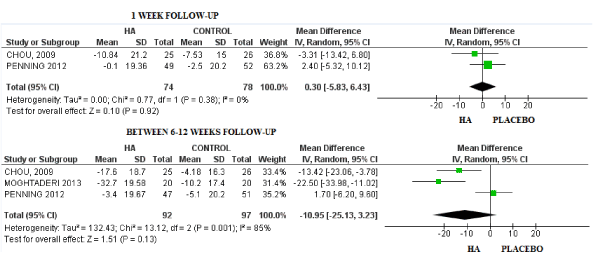Background: A need exists to better understand the impact of anxiety on functional outcomes following Traumatic Brain Injury (TBI). Anxiety has been understudied in this population with regard to the impact on functional outcomes within post-hospital rehabilitation settings.
Objectives: To evaluate the prevalence and severity of anxiety among a large group of chronic TBI adults; to determine the impact of anxiety on outcomes of post-hospital residential rehabilitation programs; and to assess effectiveness of post-hospital residential rehabilitation programs in treating anxiety.
Methods: The study included 950 adults with moderate to severe traumatic brain injury (TBI). Each subject was assigned to one of four groups based on MPAI- 4 Anxiety ratings: (1) Not Anxious, (2) Mildly Anxious, (3) Moderately Anxious, and (4) Severely Anxious. Functional status was assessed at admission and discharge with the MPAI-4 Participation Index. Differences among groups were evaluated using conventional parametric tests. Rasch analysis established reliability and validity of MPAI-4 data.
Results: Rasch analysis demonstrated satisfactory construct validity and internal consistency (Person reliability = .91-.94, Item reliability = .99). Of the 950 subjects, 46% presented with moderate to severe anxiety at admission. These subjects demonstrated significantly higher MPAI-4 Participation scores than the mild and not anxious groups. Anxiety groups realized significant improvement in symptoms, but, those remaining anxious at discharge had significantly greater disability than those who improved.
Conclusions: Anxiety symptoms had a deleterious impact on post-hospital neurological rehabilitation outcomes. Remediation of symptoms during rehabilitation significantly improved outcomes demonstrating efficacy of post-hospital care.
rotator cuff, shoulder pain, shoulder disorder glenohumeral, hyaluronic acid, hyaluronate, shoulder, viscosupplementation
Rotator cuff tendinopathy is a progressive disorder of the shoulder which begins with an acute tendinitis, progresses to tendinosis with degeneration and partial thickness tears, and results in full thickness rupture [1]. Rotator cuff tendinopathy has multifactorial etiology [2]. According to intrinsic factors, tendon degeneration would result from the combination of natural process of aging, poor vascularity, altered biology, and inferior mechanical properties. Constitutional risk factors have been shown to be associated with rotator cuff tendinopathy, including diabetes mellitus, obesity, smoking, and hyperlipidemia [3-6]. Whereas, extrinsic factors include hooked acromion, mechanical overuse, anterior glenohumeral dislocations and fractures of great tuberosity [7].
Non-steroid anti-inflammatory drugs (NSAIDs) and physical therapy are commonly recommended to restore shoulder function in rotator tendinopathy [8,9]. Diercks et al. [10] also recommended home exercises of low intensity and high frequency, combining eccentric training with stabilization training of the scapula and focusing on relaxation and proper posture.
If the results of the conservative treatment fails, corticosteroid or anesthetics injection is often used in the management of persistent shoulder pain [11]. The potential mechanism of corticosteroids include decreased inflammation, inhibition of cellular proliferation, scarring and adhesion, and anti-nociceptive action [12]. However, their effectiveness is ascertained only in the short term follow-up and occurrence of local degradation of tissues has been reported as a result of repeated corticosteroid injection, as well as tendon tearing and corticosteroid arthropathy [11]. Therefore, their use should be restricted to selected cases.
Currently, intra-articular hyaluronic acid (HA) is well accepted as a good alternative in the conservative treatment in patients with osteoarthritis [13,14]. Moreover, HA has been proposed for the treatment of tendinopathies due to its viscoelastic properties on connective tissue [15]. Indeed, some studies showed encouraging results on hyaluronic acid’s ability to promote tendon gliding and reduce adhesion as well as to improve tendon architectural organisation [15]. HA is a non-sulfated glycosaminoglycan consisting of alternately repeating D-glucuronic acid and N-acetylglucosamine units. HA could bind to specific receptors expressed in many cells, such as the cluster determinant 44 (CD44), the intracellular adhesion molecule-1 (ICAM-1) and the receptor for hyaluronate-mediated motility (RHAMM). The consequences of these connections are to stimulate cell functional activities such as cell migration and proliferation.
In a previous meta-analysis study, Saito et al. provided evidence that HA injections could be a valuable alternative to other conservative methods for the treatment of chronic painful shoulder. Only a few conclusions were drawn from this meta-analysis because of the relatively small number of studies included. The authors emphasized the need for additional investigations on the use of HA injections for the treatment and development of clinical practice guidelines for chronic painful shoulder.
Therefore, the aim of this meta-analysis is to compare the efficacy of HA injection with both placebo and corticosteroid or anaesthetic injections in patients with rotator cuff tendinopathies using pain and shoulder function as primary and secondary outcome measures, respectively.
Criteria for considering studies
Types of studies
We considered the following inclusion criteria:
- Randomized controlled trials (RCTs) of any design (e.g. parallel, cross-over, factorial);
- English-language studies;
- RCTs in which the other intervention arm used a placebo or intra-articular injections of corticosteroids.
- RCTs that reported the methods used to generate the allocation sequence or that included a statement such as “random allocation was used”.
Types of participants
We included studies involving participants with rotator cuff tendinopathy for any duration.
We excluded trials that included any participants with a history of significant trauma or systemic inflammatory conditions such as rheumatoid arthritis, hemiplegic shoulders, and pain in the shoulder region as part of a complex myofascial neck. Animal studies were also excluded.
Types of interventions
We included RCTs comparing HA injections to placebo, no treatment, corticosteroid injections, or any other intervention. Because saline solution is accepted as a placebo “treatment”, we used the term “placebo” for the administration of saline solution injections.
Types of outcome measures
- Overall pain [mean or mean change measured by visual analogue scale (VAS) [16], numerical or categorical rating scale].
- Clinical improvement, evaluated by the following shoulder functional scales:
- Assessment Shoulder and Elbow scale (ASES) [17,18];
- Constant-Murley Score [19].
Search methods for identification of studies
Electronic searches
Our search strategies included the following databases: MEDLINE, Embase, CINAHL, Google scholar web, Ovid database, Physiotherapy Evidence Database (PEDro), and the Cochrane Library. We performed a broad research for relevant study up to February 2017. Search methods for identification of studies: [("Hyaluronic Acid" OR ("Viscosupplementation") AND ("Shoulder Impingement Syndrome") OR ("Rotator Cuff Injuries") OR ("Rotator Cuff")]
Data collection and analysis
Selection of studies
Two review authors independently screened all search results (title, abstract, and descriptors) to identify studies for possible inclusion in the review. After the initial screening, they assessed all included trials for eligibility based on the full text. Any disagreements were resolved through discussion or, if necessary, through another independent researcher. Where required, we contacted study authors for additional information. When trial results were not normally distributed and so reported as median and range, the trial was not included in the meta-analysis.
Assessment of risk of bias in included studies
Characteristics of extraction data are presented in Table 1. Included studies were evaluated by 2 independent reviewers for their methodological quality using the PEDro rating scale (http://www.pedro.org.au). Elements were only scored as “yes” where quality clearly met the specified criteria. Disagreements were settled by a third reviewer. Data were then extracted and cross-checked for accuracy. The reviewers were not blinded to the authors of the articles.
Table 1. Details of randomized controlled trials of HA (hyaluronic acid) injections for rotator cuff disorders.
Author, Year |
Diagnosis |
Treatment Schedule |
Subjects (N) |
Follow Up |
Blaine et al, 2008 [29] |
OA RCT, adhesive capsulite |
- Intra-articular injection
- HA (Hyalgan) 5 weekly or 3 weekly +2 saline solution vs 5 weekly saline solution
|
660 |
- VAS: 7, 9, 13,17,26 weeks
|
Chou et al, 2009 [27] |
RCT without complete tears |
- Subacromial injection
- HA (Supartz) vs Saline solution 5 weekly
|
51 |
- VAS : 1-6 weeks
- CMS: 1-6 weeks
|
Moghtaderi et al, 2013 [28] |
SAI syndrome |
- Subacromial injection
- HA (FermathronTM ) vs Saline solution 3 weekly
|
40 |
- VAS: 1 Week
- CMS: 12 weeks
|
Penning et al, 2014[25] |
SAI syndrome |
- Subacromial injection 3 weekly
- Group A:HA (Ostenil) and 8 ml lidocaine 1%
- Group B: corticosteroid 10 mg/ml 8 ml lidocaine 1%;
- Group C: 2 ml NaCl 0.9% and 8 ml lidocaine 1%
|
150 |
- VAS: 3, 4, 12, 26 weeks
- CMS: 3, 4, 12, 26 weeks
|
YS Kim et al, 2012 [26] |
SAI syndrome |
- Subacromial Ultrasound guided
- HA (Hyruan plus) vs corticosteroid, 3 weekly
|
105 (80) |
- VAS :3, 6, 12 weeks
- ASES: 3, 6, 12 weeks
|
RCT: Rotator Cuff Tear, SAI: Subacromial Impingement; VAS: Visual Analogue Scale; CMS: Constant Murley Scale; ASES: American Shoulder and Elbow Surgeons (ASES) Assessment Form
|
We assessed the following items for each included trial: sequence generation (randomisation), allocation concealment, blinding of participants, therapists who administered the therapy and personnel outcome assessors, intention-to-treat analysis, the numbers of participants lost to follow-up and missing values.
Measures of treatment effect
For each study, mean differences (MD) or standardized mean differences (SMD) with 95% confidence intervals (CIs) were calculated for continuous outcomes using the Cochrane Collaboration’s software RevMan version 5.2 [20].
Assessment of heterogeneity
Assessment of heterogeneity between comparable trials was evaluated visually with I² statistics. Values of I² were interpreted as follows: 0%to 40% might not be important; 30% to 60% may represent moderate heterogeneity; 50% to 90% may represent substantial heterogeneity; and 75% to 100% may represent considerable heterogeneity [21].
The literature searches identified 3861 potentially relevant studies, which were assessed by their abstracts. A total of 50 titles were obtained from electronic databases after removing duplicates, no-intervention study, in vitro study or failed eligibility criteria. Of these, 44 articles were excluded because they were retrospective, experimental, and observational or not controlled study.
Following a thorough screening, we identified 7 full-text articles [22-28]. We included 5 trials [23-27] in the quantitative analysis (Figure 1).
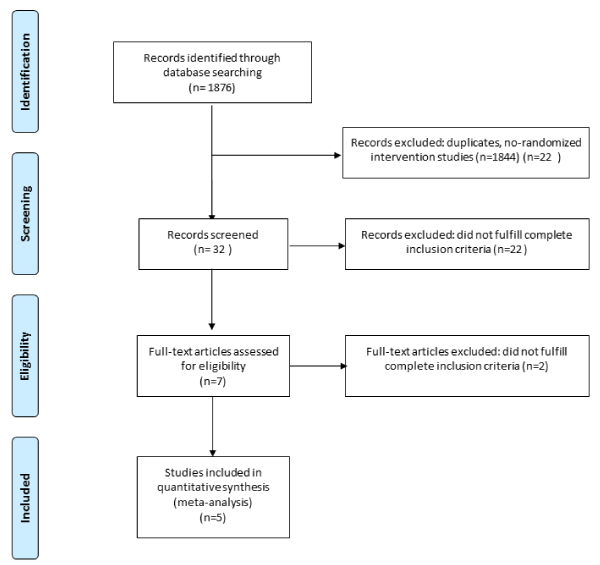
Figure 1. Literature searches identified 7 full-text articles.
Study quality
The results of the PEDro rating are shown in Figure 2. The quality of the studies as determined via the PEDro rating scale ranged from 2 to 8 out of a possible score of 10. All studies reported whether groups were equivalent at baseline. Two of the 5 studies did not use an intention-to-treat analysis. Blinding items were unclear in 2 studies (Table 2).
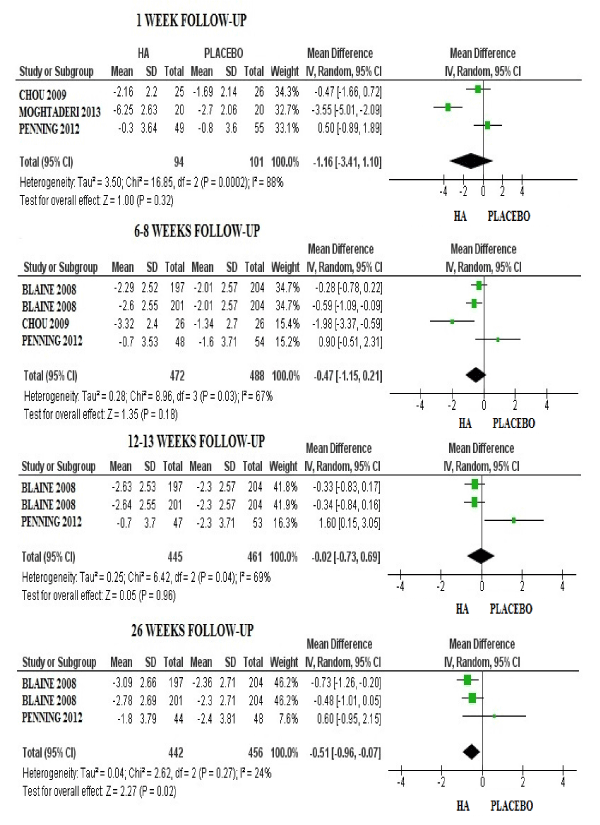
Figure 2. Results of the PEDro rating.
Table 2. The PEDro Scale.
The PEDro Scale |
BLAINE, 2008 |
CHOU, 2009 |
KIM, 2012 |
MOGHTADERI, 2016 |
PENNING, 2014 |
- Eligibility criteria were specified
|
YES |
YES |
YES |
YES |
YES |
- Subjects were randomly allocated to groups (in a crossover study, subjects were randomly allocated an order in which treatments were received)
|
YES |
YES |
YES |
YES
|
YES |
- Allocation was concealed
|
NO |
YES |
NO |
NO |
YES |
- The groups were similar at baseline regarding the most important prognostic indicators
|
YES |
YES |
YES |
YES |
YES |
- There was blinding of all subjects
|
NO |
YES |
UNCLEAR |
UNCLEAR |
YES |
- There was blinding of all therapists who administered the therapy
|
NO |
YES |
UNCLEAR |
UNCLEAR |
YES |
- There was blinding of all assessors who measured at least one key outcome
|
YES |
YES |
UNCLEAR |
UNCLEAR |
YES |
- Measures of at least one key outcome were obtained from more than 85% of the subjects initially allocated to groups
|
YES |
YES
|
YES |
YES |
YES |
- All subjects for whom outcome measures were available received the treatment or control condition as allocated or, where this was not the case,data for at least one key outcome was analysed by “intention to treat”
|
YES |
YES |
NO
|
NO
|
YES |
- The results of between-group statistical comparisons are reported for at least one key outcome
|
YES |
YES |
YES |
YES |
YES |
- The study provides both point measures and measures of variability for at least one key outcome
|
YES |
YES |
YES |
YES |
YES |
Total Score |
7 |
10 |
5 |
5 |
10 |
Sample characteristics
A total of 990 participants with rotator cuff disease were included, of which 464 were male (46.86%) and 526 were female (53.14%). Reported mean ages ranged between 51.16 and 63.6 years old. Mean age values were not available in one RCT [26]. Details regarding participant recruitment are presented in Table 1.
Hyaluronic Acid Intervention vs placebo intervention
Four studies compared HA injection with placebo injection [23,25,27], of which two used 3 weekly injections [23,26,27] and two used 5 weekly injections [25,27]. Blaine et al. [27] used 2 ml of sodium hyaluronate (10 mg/ml) in experimental groups and phosphate buffered saline solution in placebo group; Chou et al. [25] used 25 mg of ARTZ Dispo in experimental group and 2.5 ml of saline solution 0.9%; Moghtaderi et al. [26] used 20 mg/2ml of HA (Fermathron) in experimental group and 2 ml of saline solution 0.9%.
Hyaluronic Acid vs corticosteroid injection
Two studies compared HA injection with corticosteroid injection [23,24]. In Kim et al. [24] study, patients were injected once a week for three weeks with 20 mg/2ml HA (Hyruan plus) and once with 5 mg/1ml dexamethasone disodium phosphate diluted with 4ml lidocaine (2% 20 mg/ml) and 5 ml saline solution.
Whereas, Penning et al. [23] randomized subjects as follows: the HA group received 8 ml lidocaine 1% with 2 ml HA (ostenil), the corticosteroid group received 8 ml lidocaine 1% with 2 ml triamcinolone acetonide 10 mg/ml and placebo group received 8 ml lidocaine 1% with 2 ml NaCl 0.9%.
Outcome measures
2021 Copyright OAT. All rights reserv
Hyaluronic Acid Intervention vs. placebo intervention
- Pain
- Shoulder function
According to Constant-Murley Score, the meta-analysis showed no significant difference between HA group and placebo group at: a) 1 week follow-up (MD=0.30, 95% CI -5.83 to 6.43), p=0.92; b) from 6 to 12 weeks follow-up (MD= -10.95, 95% CI -25.13 to 3.23), p=0.13. The results of meta-analysis are showed in Figure 4.
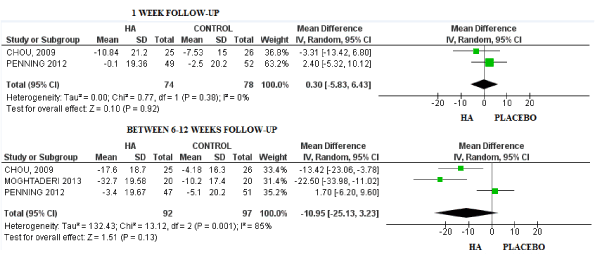
Figure 4. Results of meta-analysis in Shoulder function (Hyaluronic Acid Intervention vs placebo intervention).
Hyaluronic Acid vs. corticosteroid injection
- Pain
According to VAS score, the meta-analysis showed no significant difference between HA group and corticosteroid group at: a) 3 weeks follow-up (MD= -0.22, 95% CI -3.16 to 2.72), p=0.88; b) 6 weeks follow-up (MD= 0.22, 95% CI -3.02 to 3.47), p=0.89; c) 12 weeks follow-up (MD= -0.20, 95% CI -4.47 to 4.07), p=0.93. The results of meta-analysis are showed in Figure 5.
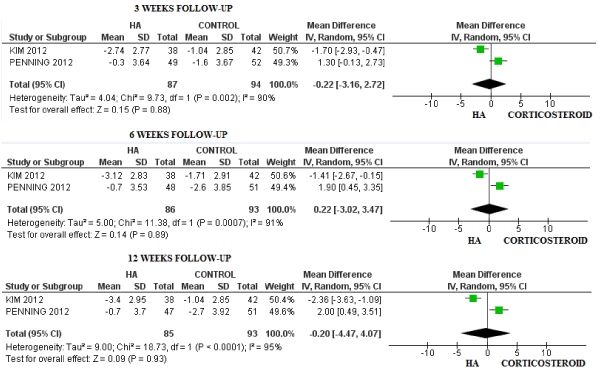
Figure 5. Results of meta-analysis in Pain (Hyaluronic Acid Intervention vs corticosteroid injection).
- Shoulder function
According to Constant-Murley Score, the meta-analysis showed no significant difference between HA group and corticosteroid injection group at: a) 3 weeks follow-up (SMD= 0.05, 95% CI -0.34 to 0.25), p=0.75;b) 6 weeks follow-up (SMD= 0.16, 95% CI -0.13to 0.46), p=0.27; c) 12 weeks follow-up (SMD= 0.07, 95% CI -0.22 to 0.36), p=0.65. The results of meta-analysis are showed in Figure 6.
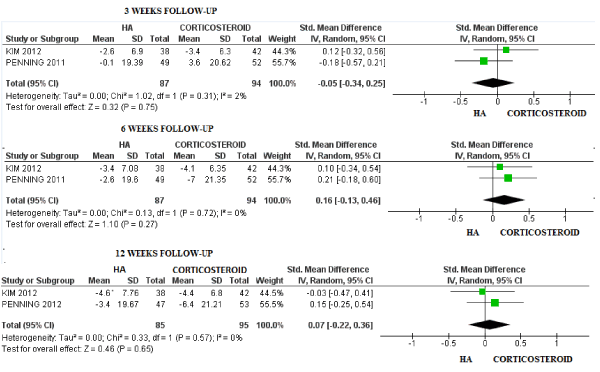
Figure 6. Results of meta-analysis in Shoulder function (Hyaluronic Acid Intervention vs corticosteroid injection).
Hyaluronic acid has been hypothesized to have an anti-inflammatory effect in patients with subacromial synovitis associated with rotator cuff disease. Histologically, subacromial synovitis consists of no-specific inflammation accompanied by proliferation of subacromial synovial fibroblasts (SSF) with less infiltration of inflammatory cells. Pro-inflammatory cytokinesand enzymes (IL-1,TNF-a, IL-6, and COX-2) produced by SSF play a major role in shoulder pain. The level of IL-1β mRNA expression in SSF correlates well with the degree of in rotator cuff disease [29]. Mitsui et al. [30] examined the anti-inflammatory effect of HA in vitro using IL-1-stimulated SSF derived from patients with rotator cuff disease. The results demonstrated that HA inhibits not only expression of mRNA for proinflammatory cytokines (IL-1b, IL-6, and TNF-a), but also COX-2/PGE2 production via CD44 in IL-1-stimulated SSF. The CD44, a transmembrane glycoprotein widely distributed on T cells, granulocytes, monocytes, fibroblasts, keratinocytes, and epithelial cells, is a major cell surface receptor for HA.
This meta-analysis compared the efficacy of HA injections with both placebo and corticosteroid injections in patients with rotator cuff tendinopathies according to pain and shoulder function as outcome measures.
Although no significant differences were found in VAS score between HA injections and both placebo and corticosteroid injections until 13 weeks and 12 weeks respectively, a significant difference in relief of pain was shown between HA injections and saline solution at 26 weeks follow-up. No significant differences exist between groups in shoulder function at follow-up.
We found a substantial clinical heterogeneity with respect to the interventions tested and only few trials were combined in meta-analysis to reach an overall conclusion about the effect of HA injection in rotator cuff tendinopathy. According to methodological quality, the results generated by our meta-analysis are, as a whole, based on trials of small participants that may be biased by Type II error (the failure to demonstrate a difference which is in truth present or false negatives). A few studies analyzed results using intention to treat principles and clearly specified blind allocation. Moreover, the meta-analysis showed different weights to the different studies that are related with the inverse of the standard error reported in the studies. Therefore, findings of no significant benefit are consistent with no evidence to support or refute the use of the HA intervention.
In a systematic review, Osti et al. [31] evaluated the potential benefit and adverse effects of HA injection in patients with rotator cuff tears. The authors included 11 studies (1102 subjects) comparing HA injections with corticosteroid injections, physical therapies and control groups. The use of HA was found to be effective in reducing pain and improving function in shoulder with rotator cuff tears without showing severe adverse reactions.
Currently, Mohamadi et al. [10], performed a meta-analysis including eleven prospective randomized controlled trials comparing corticosteroid and placebo injections. The authors found that corticosteroid injections provide minimal transient pain relief in a small number of patients with rotator cuff tendinosis and cannot modify the natural course of the disease. Moreover, multiple injections were not found to be more effective than a single injection at any time.
Despite complex study design, on HA injection there is insufficient evidence to either support or disprove this therapy for treatment of patients with rotator cuff disorder. In completing this study we had some problems: 1) there have not been many randomized controlled trials (RCT), 2) the quality of the studies that were found was not high; 3) the homogeneity of the papers that were found was low (in particular for diagnosis, inclusion criteria, HA dose and type, site of injection. For these reasons only few trials were combined in meta-analysis and to reach an overall conclusion about the effect of HA injection in rotator cuff we need more high quality data. So future studies aiming to investigate HA injection should aim to minimize bias by presenting homogeneity, with respect to dose, HA type and injection site.
- Neer CS 2nd (1983) Impingement lesions. Clin Orthop Relat Res 173: 70-77. [Crossref]
- Seitz AL, McClure PW, Finucane S, Boardman ND 3rd, Michener LA (2011) Mechanisms of rotator cuff tendinopathy: intrinsic, extrinsic, or both? Clin Biomech (Bristol, Avon) 26: 1-12. [Crossref]
- Tashjian RZ (2012) Epidemiology, natural history, and indications for treatment of rotator cuff tears. Clin Sports Med 31: 589-604. [Crossref]
- Rechardt M, Shiri R, Karppinen J, Jula A, Heliovaara M, et al. (2010) Lifestyle and metabolic factors in relation to shoulder pain and rotator cuff tendinitis: a population-based study. BMC Musculoskelet Disord 11: 165. [Crossref]
- Gumina S, Candela V, Passaretti D, Latino G, Venditto T, et al. (2014) The association between body fat and rotator cuff tear: the influence on rotator cuff tear sizes. J Shoulder Elbow Surg 23: 1669-1674. [Crossref]
- Gumina S, Candela V, Passaretti D, Venditto T, Carbone S, et al. (2014) Intensity and distribution of shoulder pain in patients with different sized postero-superior rotator cuff tears. J Shoulder Elbow Surg 23: 807-813. [Crossref]
- Via AG, De Cupis M, Spoliti M, Oliva F (2013) Clinical and biological aspects of rotator cuff tears. Muscles Ligaments Tendons J 3: 70-79. [Crossref]
- Kromer TO, Tautenhahn UG, de Bie RA, Staal JB, Bastiaenen CH (2009) Effects of physiotherapy in patients with shoulder impingement syndrome: a systematic review of the literature. J Rehabil Med 41: 870-880. [Crossref]
- Andrews JR (2005) Diagnosis and treatment of chronic painful shoulder: review of nonsurgical interventions. Arthroscopy 21: 333-347. [Crossref]
- Diercks R, Bron C, Dorrestijn O, Meskers C, Naber R, et al. (2014) Guideline for diagnosis and treatment of subacromial pain syndrome: a multidisciplinary review by the Dutch Orthopaedic Association. Acta Orthop 85: 314-322. [Crossref]
- Mohamadi A, Chan JJ, Claessen FM, Ring D, Chen NC (2017) Corticosteroid Injections Give Small and Transient Pain Relief in Rotator Cuff Tendinosis: A Meta-analysis. Clin Orthop Relat Res 475: 232-243. [Crossref]
- Abate M, Salini V, Schiavone C, Andia I (2017) Clinical benefits and drawbacks of local corticosteroids injections in tendinopathies. Expert Opin Drug Saf 16: 341-349.
- Santilli V, Paoloni M, Mangone M, Alviti F, Bernetti A (2016) Hyaluronic acid in the management of osteoarthritis: injection therapies innovations. Clin Cases Miner Bone Metab 13: 131-134. [Crossref]
- Bernetti A, Mangone M, Paoloni M, Di Sante L, Murgia M, et al. (2014) Corticosteroid and hyaluronic acid injection therapy in tennis elbow (lateral epicondylalgia). Med Dello Sport 67: 289-295.
- Kaux JF, Samson A, Crielaard JM (2015) Hyaluronic acid and tendon lesions. Muscles Ligaments Tendons J 5: 264-269. [Crossref]
- Price DD, Bush FM, Long S, Harkins SW (1994) A comparison of pain measurement characteristics of mechanical visual analogue and simple numerical rating scales. Pain 56: 217-226. [Crossref]
- Kocher MS, Horan MP, Briggs KK, Richardson TR, O'holleran J, et al. (2005) Reliability, validity, and responsiveness of the American Shoulder and Elbow Surgeons subjective shoulder scale in patients with shoulder instability, rotator cuff disease, and glenohumeral arthritis. J Bone Joint Surg Am 87: 2006-2011. [Crossref]
- Padua R, Padua L, Ceccarelli E, Bondi R, Alviti F, et al. (2010) Italian version of ASES questionnaire for shoulder assessment: cross-cultural adaptation and validation. Musculoskelet Surg 94: S85-S90. [Crossref]
- Roy JS, MacDermid JC, Woodhouse LJ (2010) A systematic review of the psychometric properties of the Constant-Murley score. J Shoulder Elbow Surg 19: 157-64. [Crossref]
- Collaboration C (2014) Review Manager (RevMan) [Computer Program] Version 5.2. 3. Copenhagen: The Nordic Cochrane Centre.
- Higgins J, Green S (2017) 9.5. 2 Identifying and measuring heterogeneity. Cochrane Handbook for Systematic Reviews of Interventions Version 50.
- Sengul I, Oz B, Yoleri O, Olmez N, Memis A, et al. (2008) Sodium hyaluronate injections compared to local modalities for the treatment of shoulder impingement syndrome/ Comparison of local hyaluronate injection with sodium hyaluronate in the treatment of shoulder constriction syndrome. Turk J Phy Med Rehabil 54: 138-43.
- Penning L, De Bie R, Walenkamp G (2012) The effectiveness of injections of hyaluronic acid or corticosteroid in patients with subacromial impingement. J Bone Joint Surg Br 94: 1246-1252. [Crossref]
- Kim YS, Park JY, Lee CS, Lee SJ (2012) Does hyaluronate injection work in shoulder disease in early stage? A multicenter, randomized, single blind and open comparative clinical study. J Shoulder Elbow Surg 21: 722-727. [Crossref]
- Chou WY, Ko JY, Wang FS, Huang CC, Wong T, et al. (2010) Effect of sodium hyaluronate treatment on rotator cuff lesions without complete tears: a randomized, double-blind, placebo-controlled study. J Shoulder Elbow Surg 19: 557-63. [Crossref]
- Moghtaderi A, Sajadiyeh S, Khosrawi S, Dehghan F, Bateni V (2013) Effect of subacromial sodium hyaluronate injection on rotator cuff disease: A double-blind placebo-controlled clinical trial. Adv Biomed Res 2: 89. [Crossref]
- Blaine T, Moskowitz R, Udell J, Skyhar M, Levin R, et al. (2008) Treatment of persistent shoulder pain with sodium hyaluronate: A randomized, controlled trial. J Bone Joint Surg Am 90: 970-979. [Crossref]
- Özgen M, Fırat S, Sarsan A, Topuz O, Ardıç F, et al. (2012) Short-and long-term results of clinical effectiveness of sodium hyaluronate injection in supraspinatus tendinitis. Rheumatol Int 32: 137-144. [Crossref]
- Santavirta S, Konttinen YT, Antti-Poika I, Nordstrom D (1992) Inflammation of the subacromial bursa in chronic shoulder pain. Arch Orthop Trauma Surg 111: 336-340. [Crossref]
- Mitsui Y, Gotoh M, Nakama K, Yamada T, Higuchi F, et al. (2008) Hyaluronic acid inhibits mRNA expression of proinflammatory cytokines and cyclooxygenase‐2/prostaglandin E2 production via CD44 in interleukin‐1‐stimulated subacromial synovial fibroblasts from patients with rotator cuff disease. J Orthop Res 26: 1032-1037. [Crossref]
- Osti L, Buda M, Del Buono A, Osti R, Massari L (2016) Clinical evidence in the treatment of rotator cuff tears with hyaluronic acid. Muscles Ligaments Tendons J 5: 270-275. [Crossref]



